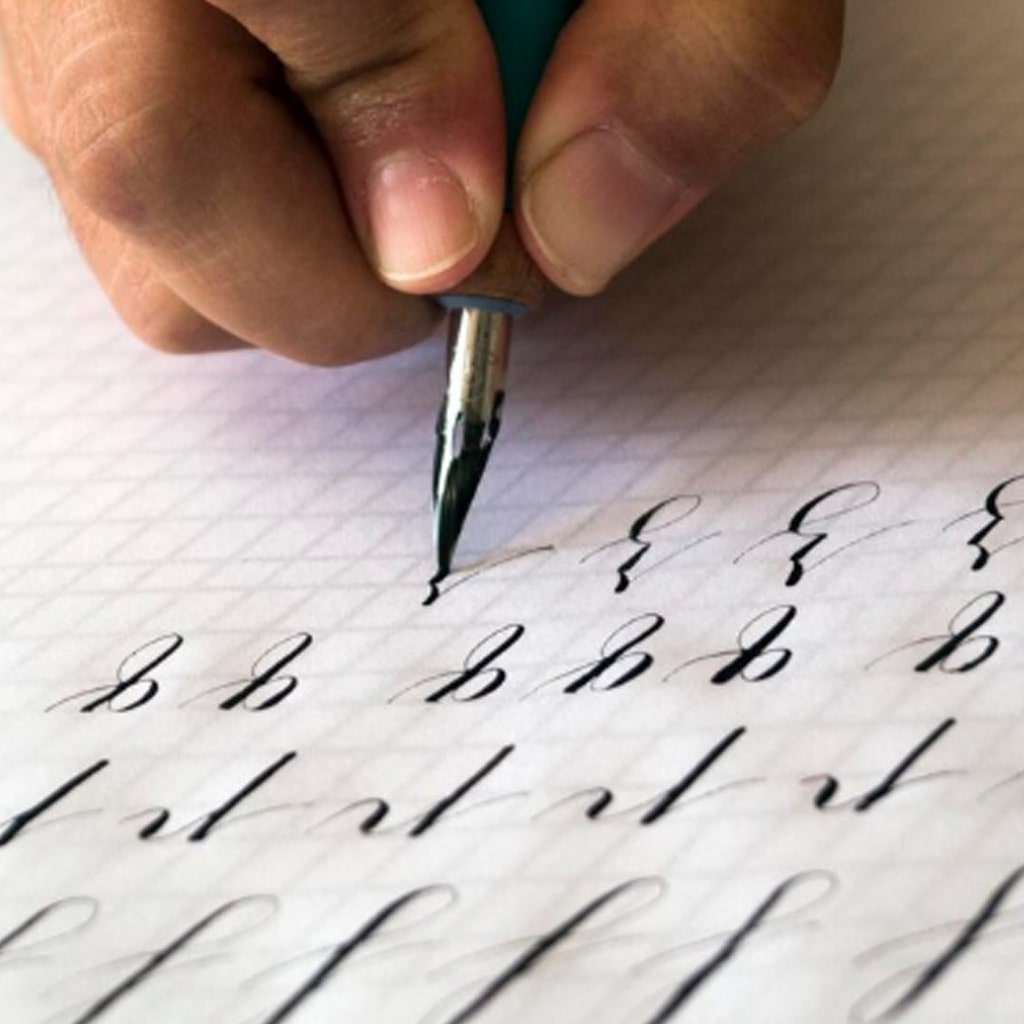

Please enter the code we just sent to whatsapp 91-11-46710500 to proceed
Didn't Receive OTP?

Learn the art of cursive writing with our step-by-step guide intended for young learners! Bambinos.live offers simple instructions on forming striking cursive alphabets, perfect for kids boarding on their new writing journey. Unveil the magic of cursive writing and observe as your kid's creative handwriting skills flourish.
Are you trying to teach something fun and interesting to your kids? Or do you just want them to improve their handwriting? Well, no matter what your goal is, there can surely be one solution- learn cursive writing. Not you, but your kids.
Yes, teaching your kids the art of writing the cursive alphabet can help to improve their understanding of the subject, memory and so much more. Honestly, these are extremely important, especially in the mental health development and growth of the kids. “But isn't it difficult to learn Cursive writing?”, you may ask. So, let us simplify the entire process to help your kids learn better. Continue reading to learn how to master the art of cursive writing.
Cursive writing is an art- a simple way through which all the characters or alphabets are connected in a flowy manner. It is also known as script and longhand writing. The students are often taught cursive writing from a very young age as it helps to write faster than the block or capital letters.
There should be a proper and strong connection between the brain and hand for the resultant cursive writing to be appropriate. Unlike block letters, cursive writing requires the kids to identify the hoops and connections for navigating the letters.
Some of the key benefits of cursive writing are as follows:
Kids can improve their functional specialization learning skills with cursive writing.
Kids who learn cursive writing have better functional and stronger muscle memory than the ones who don't.
Cursive writing practice also helps to improve memory.
Cursive letters are joint alphabets with a slanting position, slightly different from what the kids are taught from a young age. This is something new for the students. So, here's a look at how to practice cursive writing:
Strokes are one of the most important parts of cursive writing for it helps to learn more about the alphabet’s characters. Strokes reflect the presence of alphabets and characters involving lowercase, uppercase, and concave and convex letters. Therefore, you will teach the kids about how to proceed with letters such as l, b, p, j, g, a, c, and more.
Lowercase letters as cursive alphabets are the easiest ones to learn. In the initial stages, it is advisable to help the kids first understand how each lowercase letter is formed as a cursive writing.
Once they learn the formation, encourage them to practice writing lowercase cursive letters constantly. As a result, the kids would retain it in their muscle memory thereby focusing on maintaining proportions across each letter. Lowercase cursive letters are slightly more difficult to write than the uppercase ones.
Uppercase cursive alphabets are easy to learn. Practicing the strokes for uppercase letters a few times will help in getting a stronger grasp of it. However, make sure to get a complete understanding of the dimensions of it.
Uppercase cursive letters are simple, but fun to write because it has curls, loops, and tails which adds to a unique appeal to the word.
Read more: How to Make Homework Enjoyable for Kids
Once they've mastered the art of writing cursive alphabets individually, encourage them to come forward for learning connections. After all, a word can't be formed if the letters and alphabets aren't connected.
While the kids learn to connect the alphabet, help them understand how every different letter connects to the other one. Teaching them this from a young age will be good for their muscle memory thereby preventing flow disruption.
By now, the kids must have learned how to join two alphabets together. So, take one step ahead and encourage the kids to form words. In the initial stages, start with words containing lesser alphabets. Once they learn to do this, you can teach them to form a connection between the different cases.
While practicing cursive writing, it is important to use proper punctuation too. This plays an important role in personalizing the writing experience. After all, every kid will have their own variation with the letters.
The individual letters and their connections should be connected. This helps to form meaningful compositions. As a result, it helps to present the word in a better way. In the initial stages, start with easy words and then move on with the mix of uppercase and lowercase letters.
Use punctuation to maintain a smooth and natural flow. It is best to use variations to improve the cursive writing letter and then personalize it as per the requirements.
Ligatures refer to the practice of how two letters are connected, for example, ch, th, and so on. While the kids are learning cursive writing, help them understand the concept of ligatures and how each of them is different. Remember, it's an art so there's no stringent rule surrounding it.
This further plays a vital role in maintaining the aesthetic appeal of the information. While discovering the ligatures, it is important to maintain a smooth transition. Therefore, it is vital to choose the ligatures that naturally align with information.
Read more: 5 Ways to Deal with a Stubborn Kid
Cursive handwriting has a slant towards it through which every letter will bend to a perfect angle as if leaning onto each other. Maintaining a slant is important for improving visual appeal and professionalism.
There's no one-size-fits-all for cursive scripts. Therefore, it is advisable to maintain a consistent slant across every letter. Pay attention to maintaining uniformity for the slants in all cursive letters.
While doing cursive writing practice, pay attention to flourishes as well. Every flourish is meant to add personality to the letters with the proper use of loops and strokes. Practicing with flourishes helps in offering self-expression for elegance and individuality via cursive writing.
It is advisable to opt for a balanced composition and avoid overly ornate decorations. Thus, make sure to maintain readability for measuring the visual appeal. Teach the kids to maintain a signature flourish that will set your cursive writing different from others.
Encourage the kids to practice regularly with cursive writing. Constant practice plays an important role in reinforcing muscle memory thereby allowing the kids to master cursive writing. Practicing for 10-15 minutes daily can help the kids improve their cursive writing skills. It is advisable to help the kids practice extra daily so that they can address their challenges and eventually overcome them.
As children move towards their experience of learning cursive writing, it is important to teach them writing tips. Basic information can go a long way, especially in terms of determining success. Some of the key tips to follow for cursive writing practice are as follows:
Whether the child is a beginner or an expert, it is always a good idea to use guided worksheets. These guided worksheets act as step-by-step guidelines that help in learning about letter formation, connections, and more. Furthermore, it also caters to improving the script aesthetics.
Spacing is one of the most important things to consider for cursive writing. Not only does it help to improve the visual appeal, but also contributes to improving readability. Maintaining adequate spacing between the words makes it easier for individuals to separate the words and understand the message.
Read more: 5 Interesting DIY Crafting Activities for Children
It is important to constantly send feedback about cursive writing to the kids. This plays an important role in enhancing the quality of assignments. Furthermore, it is also important to improve the overview of the writing as well.
Cursive writing is one of the best aspects to improve penmanship. It is crucial for the kids to begin with learning cursive writing. The best way would be to encourage the kids to start the journey and then encourage them to practice cursive writing as much as possible. This is important for managing strokes, curves, and connections between the letters to improve cognitive growth, expression, and artistic identity. Encourage the kids to start with the basics of cursive writing and then help them advance.
Q:. What are the benefits of learning cursive writing?
Ans:. Learning cursive writing can help to improve cognitive skills and also affects the way through which you read comprehension. It helps in coordinating hand and neural movement thereby fostering intellectual growth and overall development.
Q:. When should kids learn cursive writing?
The best age for the kids to learn cursive writing is from 7 to 8 years old. This is the right age when the kids will get an opportunity to improve their fine motor skills that will be required for cursive writing.
Shape Your Kid's Future with Bambinos Classes | Bambinos.live India's No. 1 English Communication Platform For Kids | Book a Free Class Now